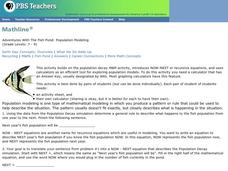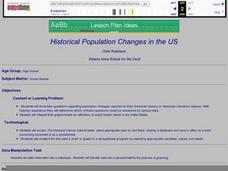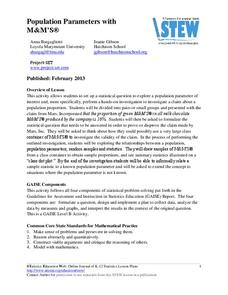Population Teacher Resources
Find Population lesson plans and worksheets
Showing 8,855 resources
PBS
Adventures With The Fish Pond: Population Modeling
Build up from the previous activity where your learners charted the population growth and decay of a fish pond with M&Ms®. Have them look at the data from that activity and create a Now-Next, or recursive equations, to predict the...
Curated OER
AP: Chapter 23: The Evolution of Populations
How and why do populations change over time? AP biology aces explore this question by completing this assignment. They write the answers to 21 questions regarding population genetics, stability, genetic drift, polymorphism, and...
TED-Ed
Population Pyramids: Powerful Predictors of the Future
Here is a very interesting visual for analyzing a country's shift from a pre-industrial society to one with an industrial or post-industrial economy. The video explains how a population pyramid is used to track a country's...
Curated OER
Historical Population Changes in the US
High schoolers conduct research on historical population changes in the U.S. They conduct Internet research on the Historical Census Data Browser, create a bar graph and data table using a spreadsheet program, and display and interpret...
Curated OER
Population Growth
A single slide depicts the normal population growth curve. The curve reaches a steady state when the population reaches carrying capacity. You can use this slide when teaching about populations, but it may be more effective to insert it...
Science 4 Inquiry
The Ups and Downs of Populations
As the reality of population decline across many species becomes real, pupils learn about the variables related to changes in populations. They complete a simulation of population changes and graph the results, then discuss limiting...
Concord Consortium
Center of Population
Let the resource take center stage in a lesson on population density. Scholars use provided historical data on the center of the US population to see how it shifted over time. They plot the data on a spreadsheet to look the speed of its...
Statistics Education Web
Population Parameter with M-and-M's
Manufacturers' claims may or may not be accurate, so proceed with caution. Here pupils use statistics to investigate the M&M's company's claim about the percentage of each color of candy in their packaging. Through the activity,...
EngageNY
Margin of Error When Estimating a Population Proportion (part 2)
Error does not mean something went wrong! Learners complete a problem from beginning to end using concepts developed throughout the last five lessons. They begin with a set of data, determine a population proportion, analyze their result...
Illustrative Mathematics
Modeling London's Population
Looking at London's population from 1801–1961 in 20 year increments, high school mathematicians determine if the data can be modeled by a given logistic growth equation. They explain their thinking and determine the values of each...
EngageNY
Population Problems
Find the percent of the population that meets the criteria. The 17th segment of a 20-part unit presents problems that involve percents of a population. Pupils use tape diagrams to create equations to find the percents of subgroups...
Crash Course
Population Genetics: When Darwin Met Mendel
Learners explore population genetics, or how populations of species change over time, leading to evolution with a video that brings together the principles of Mendel and Darwin and explains and models the Hardy-Weinberg equation.
Crash Course
Population Ecology: The Texas Mosquito Mystery
While 80 percent of people with West Nile Virus show no symptoms, in severe cases, it causes death by infecting the membranes around the spinal cord and brain. The video starts by making population ecology relevant. It includes density...
EngageNY
Understanding Variability When Estimating a Population Proportion
Estimate the proportion in a population using sampling. The 20th installment in a series of 25 introduces how to determine proportions of categorical data within a population. Groups take random samples from a bag of cubes to determine...
National Gardening Association
Migration Mishaps
Elementary ecologists pretend to be migratory hummingbirds. They fly between wintering and nesting grounds, trying to reach a habitat haven. In a musical-chair fashion, some birds will miss out, and are removed from the game. To further...
Ricochet Science
Determining a Population's Mean, Range, and Percent of Range
Staticians and researchers can learn many things about a population using just a few numbers. Viewers learn how to describe populations with statistical values in the seventh installment of an 11-part Math in Science video series. The...
Teach Engineering
Biomes and Population Dynamics - Balance Within Natural Systems
How large can a population become? The fifth installment of a nine-part unit teaches young ecologists about limiting factors that determine the carrying capacity of species in the Sonoran Desert. Here is a PowerPoint to help present this...
Teacher's Pet
Population Dynamics
Some scientists believe the earth is already over its carrying capacity for humans. The video explains what a carrying capacity is and the limiting factors to consider. It also teaches how to calculate growth rate, interpreting growth...
statisticsfun
How to Calculate Margin of Error Confidence Interval for a Population Proportion
Teach how to find a confidence interval from a population proportion and margin of error with a video that reviews how to find a population proportion and a margin of error. The instructor then explains how to create a confidence...
Curated OER
Calculating Population Growth for a Region
Students research population growth of regions of Canada. In this Social Studies lesson, students use included links on the Internet to find information about population growth in areas of Canada. A worksheet for each region is included....
Curated OER
African American Population Shifts
Middle schoolers investigate population trends. In this African American history lesson, students access U.S. Census records from 1900 to the present online. Middle schoolers analyze the migration of African Americans from one area of...
Curated OER
Population Growth
Students grow duckweed, observe what happens when an organism population is allowed to grow without predation or competition, view videos about invasive species, and develop a proposal for controlling the growth of an invasive species in...
Curated OER
Populism and the People’s Party
Students examine the history of the Populist Party as it relates to its reforms and economic plight. In this Populism and the People's Party lesson, students explore why farmers experienced financial difficulty at the end of the century....
Digital History
Representation: By State or by Population
Should representation in the new United States government be based on population? This worksheet illustrates the details of this important quandary through an adaptation of speeches on the topic given at the Constitutional Convention....
Other popular searches
- Population Ecology
- Population Genetics
- Population Density
- Population Biology
- Population Growth
- Population Geography
- Human Population
- World Population
- Population Distribution
- Aging Population
- Populations and Ecosystems
- Human Population Growth

























